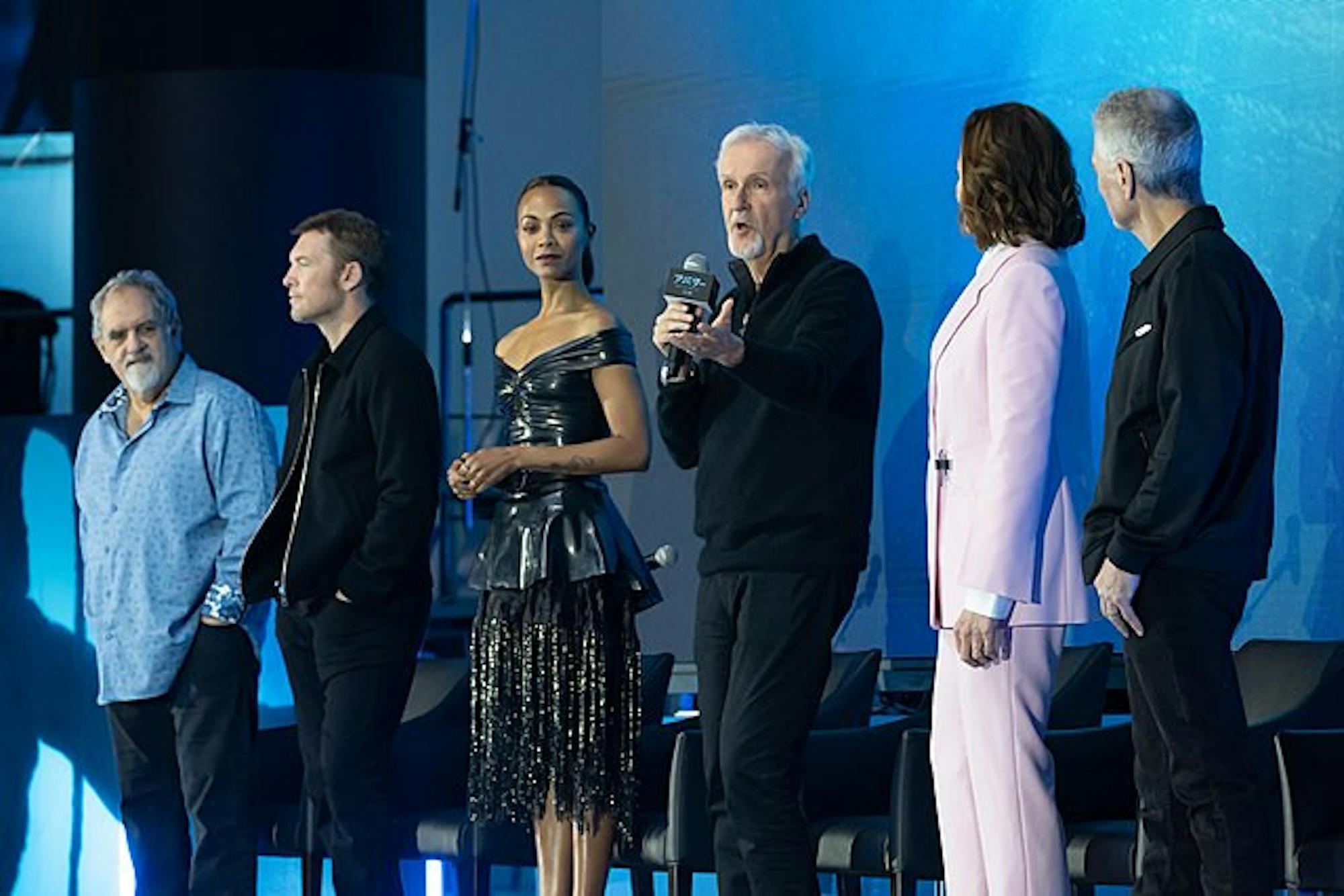Warning: This review contains spoilers for “Avatar: The Way of Water” (2022).
On Dec. 10, 2009, James Cameron’s “Avatar” premiered, an epic science fiction movie that took viewers on a cinematic journey to the distant moon of Pandora, complete with its dense forests, fantastic beasts and resilient inhabitants. Its thematic elements (colonialism, environmental destruction, human greed, war) provoked socio-cultural conversations all over the world, and it broke records to become the highest-grossing film ever at just over $2.9 billion. When adjusted for inflation, it is the second highest behind “Gone with the Wind” (1939). It revolutionized 3D viewing; it was cinema in a new form. Thirteen years later, “Avatar: The Way of Water” expands on the anthropology of Pandora, taking audiences from its forests to its oceans.
The movie opens with Jake Sully (Sam Worthington) filling viewers in on what has transpired since the events of the first movie. His family with Neytiri (Zoe Saldaña) has grown with the birth of four children: the dutiful Neteyam (Jamie Flatters), the rebellious Lo’ak (Britain Dalton), the mischievous Tuk (Trinity Jo-Li Bliss) and an adopted daughter, the broody Kiri (in a weird but welcome plot twist, played by Sigourney Weaver), who is the biological daughter of Grace Augustine from the first movie.
Most humans have left Pandora, aside from a few scientists and Spider (Jack Champion), the son of Miles Quaritch (Stephen Lang), the antagonist from the first film. Life is peaceful until events take a turn for the worse with the return of the Sky People and the Resources Development Administration. An old evil returns in the form of Colonel Quaritch, who manages to capture Spider. Jake and Neytiri, worried that Spider could lead the humans to their base, seek asylum with an oceanic clan, the Metkayina, led by Tonowari (Cliff Curtis) and his formidable wife Ronal (Kate Winslet). The film follows the Sully family as they struggle to adapt to their new way of life against the backdrop of the larger conflict with the humans, as Quaritch, hell-bent on revenge, attempts to hunt Jake down with a reluctant Spider in tow.
The film wastes no time in establishing its themes and major plotlines. In one of the first scenes, Jake reprimands his sons for taking unnecessary risks on a raid. He tells Neytiri that, as their father, it is his duty to be hard on them, which paves the way for an obvious existential teenager versus stern father storyline. Lo’ak’s reaction to Tsireya’s (Bailey Bass) graceful emergence from the water prompts an impending love story, albeit one that adds a little light-heartedness to the otherwise serious tone.
Quaritch’s scenes are characterized by tense moments with Spider, macho military lingo and his inability to let go of his thirst for vengeance, building up to an intense but unsurprising confrontation. The plot of the movie is essentially the same as its predecessor: The Na’vi are faced with threats from the humans, there are big battle sequences and Neytiri wails in anger at the actions of the Sky People. The twists in the story are predictable and superficial, while the message of the movie would have been more subtle if the writers had stamped the words “familial loyalty” on every scene, instead of having Jake wax eloquent with unnecessary metaphors.
However, the visual aspect of “Avatar” helps compensate (to some extent) where its script falls short. The cinematography of the movie makes the wait worth it — from the glorious biodiversity of the underwater world to the intense action sequences to the image of Lo’ak and his Tulkun (a whale-like species) friend Payakan and the shot of the characters entering the Three Brothers (a rock formation) — the movie retains the innovative elements of Cameron’s filmmaking that won him his reputation. His attempts to integrate newer themes into the foundations of the franchise are not entirely unwelcome either — the Sully children’s confrontation of issues like finding their identity and fitting in with the hostile Metkayina youth add a coming-of-age element that many viewers can relate to.
Numerous scenes will undoubtedly keep you on the edge of your seat, such as Kiri connecting with the ethereal Spirit Tree, an action that brings about a heartfelt moment with her mother. The looting of the coastal villages captures the abject brutality of the Resources Development Administration and the collateral damage resulting from their efforts to suppress opposition to their regime, while the simultaneous return of the Tulkun to Tonowari’s village provides a much-needed scene of communal joy amid the fire and the guns.
Overall, the movie is a visual treat, but it’s held back by the limitations of repetitive elements and a predictable script. One can only hope that its sequel will offer a story as fresh as the first movie offered, carrying on the legacy Cameron has established by creating a space for conversations about issues of global significance in pop culture.
The third “Avatar” installment is scheduled to hit theaters in December 2024 and will carry on the storylines of the Sully family and their Metkayina friends. New faces in the “Avatar” franchise will include Michelle Yeoh, Oona Chaplin and David Thewlis.






